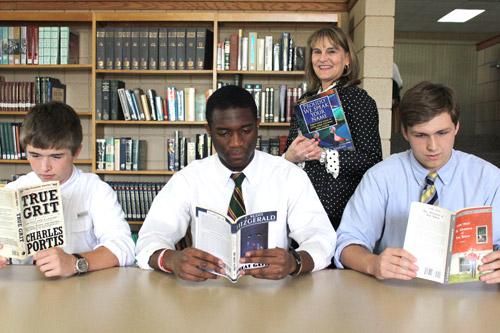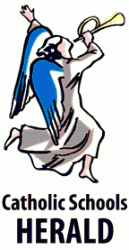

Among the many traditions driving life at Catholic High School in Little Rock is “the list” — the roster of books each student must complete. It’s a heady dose of literature for each year’s student body, capably shepherded by generations of the English department.
“First and foremost, the list gets the boys interested in reading,” said Gretchen Gowen, department head and a member of Our Lady of the Holy Souls Church in Little Rock. “Books start fairly easy and then become more challenging.”
No one can remember precisely when the list got started including Gowen, whose reign as department chair followed Mike Moran’s retirement in 2008. Moran, who cultivated the list for 41 years before that, can’t pinpoint its genesis, either.
“It goes back to the late 1950s at least,” he said. “It was here when I was a student.”
Incoming classes are more than aware of the list by the time they report for freshman year, seeing as how the first of its 32 titles, Moran’s “Proudly We Speak Your Name,” is assigned in the intervening summer between eighth and ninth grade. (Moran’s novel, “Jesse Crosse,” was published in 2011 and added to the sophomore reading list.)
“We give each student his first book of the year at registration,” Gowen said of the 2009 book. “This shows students Catholic High values reading and that we are serious about academics from the first day they set foot on campus. We expect the students to have finished the first book by the first of September.”
Criteria for considering books are, as Gowen puts it, “when they meet a delicate balance of interest level for the boys and value as a piece of literature.”
“We are heavily into ‘boy’ books,” she said. “We don’t apologize for this. We’ve got to keep our audience interested.”
It’s not mere machismo that forsakes lacy Victorian romance in favor of a beefy western like “True Grit,” by Charles Portis; more like experienced fishermen who know the best lure with which to hook their walleyed, teenaged quarry.
Moran himself remembers tearing through “The Good Earth” by Pearl Buck, searching in vain for the supposedly salacious passages about the main character and his mistress. He said such topical appeal is increasingly important to inspiring literary appreciation in students awash in opportunities to cut corners.
“Students in the modern era have all of these shortcuts, like Cliffs Notes and Spark Notes,” he said, “and any kid with the IQ of a turnip knows all of them.”
The list is evaluated annually. To make changes, teachers submit a review of proposed books to fellow department members teaching the affected grade. Only those teachers are allowed a vote. Even the sprightly Gowen has no official say in works that are taught in classes other than hers.
In a system where the department head cannot vote on a work that doesn’t affect her syllabus, you can imagine how much sway the outside world holds. Still, teachers receive the occasional outside suggestion and even voted in a title recommended by an alumnus once, to mixed reviews. But no one bullies a book on or off.
“One irate mother complained about ‘The Catcher in the Rye’ by J.D. Salinger,” Moran remembers. “She wanted to know why her son was reading such a vulgar book and (English teacher) Jim Wells told her, ‘Because it’s the last book Father (George) Tribou assigned before he died.’ And that was it. It was the best comeback I ever heard.”
One title holding a special place in Catholic High lore, is “The Lords of Discipline,” by Pat Conroy. The thinly-veiled and not-altogether-flattering account of his time at The Citadel was, not surprisingly, banned at the military college and for decades, the author along with it. Its coming of age tales told in the common vernacular makes it wildly popular among students; the back-story of friendship between Conroy and Msgr. Tribou only adds to its appeal.
As legend has it, Msgr. Tribou broke the ice by admonishing Conroy on the language he used in his books.
“Father Tribou told Pat Conroy he needed to clean up his act. Conroy told him that this is how his characters have to speak,” Gowen said when asked to separate fact from urban legend. “Oh yeah, that actually happened.”
Gowen said works aren’t included just because they raised hackles here and there, but the department doesn’t shy from them, either. The current list includes 19 titles that have been yanked off shelves, some as recently as 2009.
“Almost every book on our list has been banned or challenged somewhere,” Gowen said. “As teachers in a Catholic school, we are not afraid to tackle the social justice issues presented in the books.”
Moran said the very controversy surrounding a work is instructive, giving students a glimpse of the time into which the work was introduced and demonstrating the way the book and the thoughts behind it impacted the status quo.
“The N-word appears 281 times in ‘The Adventures of Huckleberry Finn,’ but the people who would ban it for that just don’t get it,” he said. “Here’s a young man rebelling against the most entrenched values of his time, to the point he says if it means he’ll go to hell for it, well all right then.
“If one of my books got banned for something like that, it would be an honor. I’d be in great company.”
Please read our Comments Policy before posting.
Article comments powered by Disqus Don’t let misconceptions cause faith to waver
Don’t let misconceptions cause faith to waver
 Seniors, whatever storms may come, Jesus will be there
Seniors, whatever storms may come, Jesus will be there
 Studio 3:16 offers new approach to teaching religion
Studio 3:16 offers new approach to teaching religion
 After three decades, NLR principal plans to retire
After three decades, NLR principal plans to retire
 CHS athlete overcomes odds to reach collegiate goal
CHS athlete overcomes odds to reach collegiate goal
 St. Joseph a model of solidarity with immigrants
St. Joseph a model of solidarity with immigrants
 Two gifts after Jesus’ death: Virgin Mary and Eucharist
Two gifts after Jesus’ death: Virgin Mary and Eucharist
 Why we have an altar, and not just a communion table
Why we have an altar, and not just a communion table
 Pope: Wars should be resolved through nonviolence
Pope: Wars should be resolved through nonviolence
 Living relationship with Jesus Christ in the Eucharist
Living relationship with Jesus Christ in the Eucharist